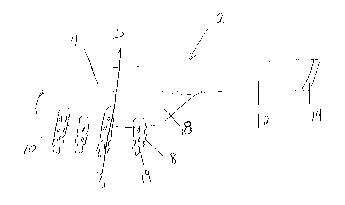Some of the information on this Web page has been provided by external sources. The Government of Canada is not responsible for the accuracy, reliability or currency of the information supplied by external sources. Users wishing to rely upon this information should consult directly with the source of the information. Content provided by external sources is not subject to official languages, privacy and accessibility requirements.
Any discrepancies in the text and image of the Claims and Abstract are due to differing posting times. Text of the Claims and Abstract are posted:
| (12) Patent Application: | (11) CA 2234295 |
|---|---|
| (54) English Title: | FLUID DISPENSING DEVICE |
| (54) French Title: | DISPOSITIF DE DISTRIBUTION DE LIQUIDES |
| Status: | Deemed Abandoned and Beyond the Period of Reinstatement - Pending Response to Notice of Disregarded Communication |
| (51) International Patent Classification (IPC): |
|
|---|---|
| (72) Inventors : |
|
| (73) Owners : |
|
| (71) Applicants : |
|
| (74) Agent: | MACRAE & CO. |
| (74) Associate agent: | |
| (45) Issued: | |
| (22) Filed Date: | 1998-04-07 |
| (41) Open to Public Inspection: | 1999-10-07 |
| Examination requested: | 2003-02-06 |
| Availability of licence: | N/A |
| Dedicated to the Public: | N/A |
| (25) Language of filing: | English |
| Patent Cooperation Treaty (PCT): | No |
|---|
| (30) Application Priority Data: | None |
|---|
A device for dispensing fluid is provided which evenly applies fluid products
to hair while the hair is being separated with the device. Combing is thereby
facilitated
and assisted by dispensing conditioner with the device. The device comprises a
head, a
plurality of teeth and a handle connected to the head. The teeth are removably
attached
to a front plate of the head. A shock absorber element provides an interface
between a
back plate of the head and the front plate. Flexibility of the front plate and
removability
of the teeth provide an improved combing/fluid dispensing device.
Note: Claims are shown in the official language in which they were submitted.
Note: Descriptions are shown in the official language in which they were submitted.

2024-08-01:As part of the Next Generation Patents (NGP) transition, the Canadian Patents Database (CPD) now contains a more detailed Event History, which replicates the Event Log of our new back-office solution.
Please note that "Inactive:" events refers to events no longer in use in our new back-office solution.
For a clearer understanding of the status of the application/patent presented on this page, the site Disclaimer , as well as the definitions for Patent , Event History , Maintenance Fee and Payment History should be consulted.
| Description | Date |
|---|---|
| Application Not Reinstated by Deadline | 2007-04-26 |
| Inactive: Dead - Final fee not paid | 2007-04-26 |
| Deemed Abandoned - Failure to Respond to Maintenance Fee Notice | 2007-04-10 |
| Deemed Abandoned - Conditions for Grant Determined Not Compliant | 2006-04-26 |
| Inactive: IPC from MCD | 2006-03-12 |
| Inactive: IPC from MCD | 2006-03-12 |
| Inactive: IPC from MCD | 2006-03-12 |
| Inactive: IPC from MCD | 2006-03-12 |
| Notice of Allowance is Issued | 2005-10-26 |
| Letter Sent | 2005-10-26 |
| Notice of Allowance is Issued | 2005-10-26 |
| Inactive: Approved for allowance (AFA) | 2005-08-31 |
| Letter Sent | 2003-03-04 |
| Request for Examination Requirements Determined Compliant | 2003-02-06 |
| All Requirements for Examination Determined Compliant | 2003-02-06 |
| Request for Examination Received | 2003-02-06 |
| Application Published (Open to Public Inspection) | 1999-10-07 |
| Inactive: Cover page published | 1999-10-06 |
| Inactive: Correspondence - Formalities | 1999-07-05 |
| Inactive: First IPC assigned | 1998-07-23 |
| Classification Modified | 1998-07-23 |
| Inactive: IPC assigned | 1998-07-23 |
| Inactive: Filing certificate - No RFE (English) | 1998-06-18 |
| Filing Requirements Determined Compliant | 1998-06-18 |
| Application Received - Regular National | 1998-06-16 |
| Abandonment Date | Reason | Reinstatement Date |
|---|---|---|
| 2007-04-10 | ||
| 2006-04-26 |
The last payment was received on 2006-04-07
Note : If the full payment has not been received on or before the date indicated, a further fee may be required which may be one of the following
Please refer to the CIPO Patent Fees web page to see all current fee amounts.
| Fee Type | Anniversary Year | Due Date | Paid Date |
|---|---|---|---|
| Application fee - small | 1998-04-07 | ||
| MF (application, 2nd anniv.) - small | 02 | 2000-04-07 | 2000-04-07 |
| MF (application, 3rd anniv.) - small | 03 | 2001-04-09 | 2001-03-19 |
| MF (application, 4th anniv.) - small | 04 | 2002-04-08 | 2002-03-12 |
| Request for examination - small | 2003-02-06 | ||
| MF (application, 5th anniv.) - small | 05 | 2003-04-07 | 2003-02-17 |
| MF (application, 6th anniv.) - small | 06 | 2004-04-07 | 2004-04-07 |
| MF (application, 7th anniv.) - small | 07 | 2005-04-07 | 2005-01-06 |
| MF (application, 8th anniv.) - small | 08 | 2006-04-07 | 2006-04-07 |
Note: Records showing the ownership history in alphabetical order.
| Current Owners on Record |
|---|
| FERNANDO P. PAGLERICCIO |
| CHESTER F. GIRARD |
| Past Owners on Record |
|---|
| None |